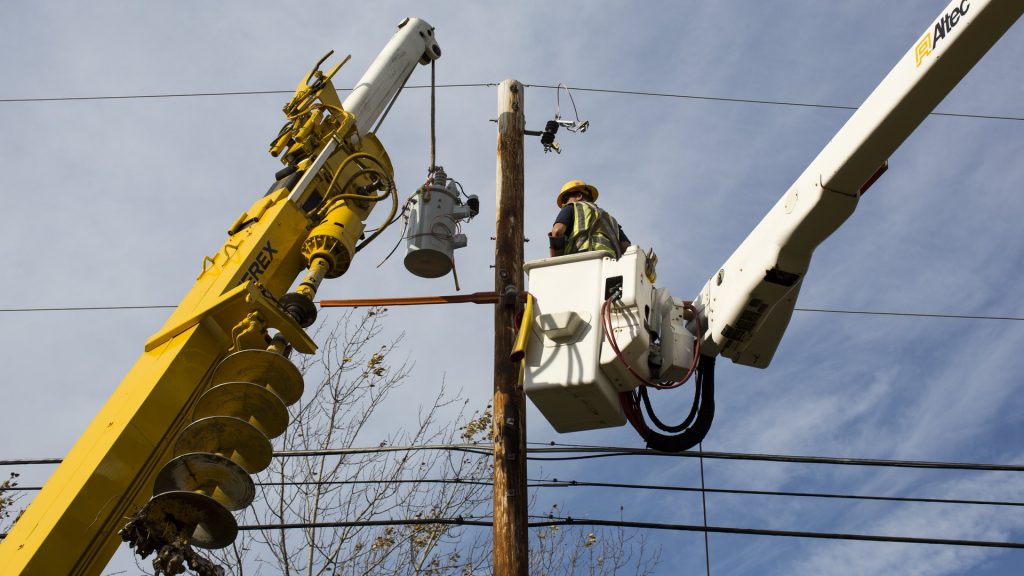Most energy execs fear ‘major incident’ on power grid due to aging infrastructure

American energy companies are concerned that the infrastructure that makes up the power grid is aging, but some experts say more money goes toward new projects than repairs. A new survey found that 9 in 10 energy executives believe a preventable major incident on the power grid or pipelines will occur due to deteriorating infrastructure.
The Energy Infrastructure Index, a report created by the company Swiss Drones and research firm Censuswide, surveyed 100 corporate executives at oil, gas and utility companies in the United States and Canada. The concerns extend beyond single disasters: 87% predict dramatic increases in service interruptions over the next five years, while 96% worry about the ability of their company’s infrastructure to withstand large storms.
“Extreme weather events are battering aging energy infrastructure across the continent and, as our data shows, energy executives say it is only a matter of time before an incident occurs,” said Ulrich Amberg, CEO of Swiss Drones, in a foreword to the infrastructure report.
Swiss Drones is a Zurich-based company that manufactures and operates unmanned helicopters for monitoring utility and pipeline infrastructure.
The results reflect growing fears in the electric utility industry. Power companies have faced harsh penalties when power lines are involved in sparking wildfires. Hurricanes and other extreme weather events have unearthed power lines, in some cases leading to weeks-long outages and billions of dollars in damage. Energy infrastructure is aging at the same time that electricity demand is surging, and consumers are starting to see increased bills.
What is the state of energy infrastructure?
Experts agree that American energy infrastructure is in need of significant upgrades. In 2025, the American Society of Civil Engineers rated U.S. energy infrastructure with a D+ grade, a decrease from the C- grade the group assigned in 2021.
Unbiased. Straight Facts.TM
87% of energy executives predict dramatic increases in service interruptions in the next five years, according to a survey from Swiss Drones.
“Nobody’s system is brand new,” said Joshua Rhodes, a research scientist at the University of Texas at Austin, in an interview with Straight Arrow News. Rhodes wasn’t surprised by the high number of executives who pointed to aging infrastructure as a cause for concern, and he said increased energy needs from AI data centers and electrified transportation are “adding more stress to an already antiquated system.”
Much of the U.S. electric grid was built in the 1960s and 1970s, according to the Department of Energy, and 70% of transmission lines that carry power over long distances from where it’s generated to population centers are now over 25 years old. Many transmission lines are nearing the end of their typical 50-80 year lifecycle, the DOE said.
How will this impact affordability?
The Swiss Drones report found that 92% of energy executives expect that decaying infrastructure will be a major driver of increased consumer prices over the next decade. Utility companies in 41 states have asked regulators to approve electric rate increases that go into effect in 2025 or 2026.
While there’s agreement that America’s energy infrastructure needs updating, it’s less clear whether upgrades and maintenance are a major factor driving up costs.
Noah Dormady, an energy economist at Ohio State University, said when it comes to increased costs, the bulk of spending isn’t going toward repairing degraded assets. Dormady pointed to data showing that the bulk of costs go toward “supplemental projects” — new infrastructure for data centers and developments — rather than repairs.
Utility companies, he said, have an incentive to play up the need for new investments, because that can justify price increases that give utilities a higher rate of return.
“It’s much easier to motivate by fear,” Dormady told SAN. “Fear of infrastructure decaying and power that you need not being there when you need it can really drive decisions, but that’s not where that money is going.”
Are drones a solution to aging energy infrastructure?
Electric utility companies have taken serious financial hits as a result of wildfires caused, in part, by their equipment. To prevent disasters, companies like PG&E in California, which filed for bankruptcy after having to pay $25.5 billion in fire-related liabilities, have to monitor hundreds of miles of power lines.
In an interview with SAN, Amberg said companies are “frightened” that they could cause the next deadly and expensive disaster, and as a result, more of them are turning to drones as a solution.
Currently, the industry largely relies on manned helicopters to inspect power lines over long distances; however, this method has limitations.
“The way you fly with a manned helicopter is never a repeatable autopilot mission, which leads to very, very different sets of data,” Amberg said.
By contrast, automated drones can make identical flight patterns, generating more reliable data that can be analyzed for changes over time. Amberg said companies can then use artificial intelligence to detect potential problems. Amberg also pointed to reduced emissions from larger helicopters and the potential to save lives because a human pilot on a flight with inherent danger is not needed.
However, regulatory barriers have slowed adoption. Amberg said it took Swiss Drones about three years to receive approval from the Federal Aviation Administration for long-range infrastructure inspections. The Trump administration has since issued an executive order directing the FAA to release permanent regulatory frameworks within two years, which Amberg said could accelerate the industry’s shift toward automated inspections.
The post Most energy execs fear ‘major incident’ on power grid due to aging infrastructure appeared first on Straight Arrow News.





